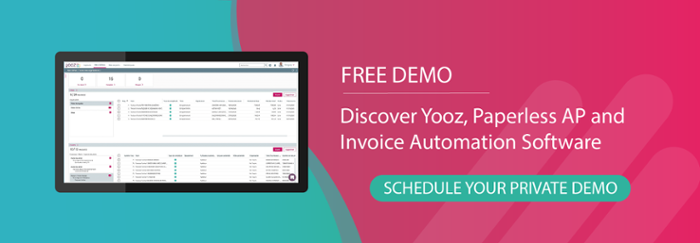Contrary to the proverb, timing is not everything. Companies that want to pay their bills on time, every time, need to have a system in place to make sure that incoming invoices are not only processed to meet specific deadlines, but are also free of errors and potentially costly mistakes. This requires a workflow built around an approval matrix that defines in detail who reviews and approves invoices according to several variables, with everything easily defined when internal circumstances change or new suppliers come onboard.
Accounts Payable automation is the easiest and most reliable way to achieve this goal, addressing accounting pain points and ensuring smooth operations in the finance department. It’s all about intelligent digitalisation and automation that do away with paper where possible, while clearly laying out the cascade of decisions specific team members have to make to approve an invoice and set it up for payment.

Key questions about the Accounts Payable workflow for invoice approval
Think about this way: You have an invoice in the system that’s due to be paid. There are two key questions that need to be answered:
- Did the right individual (or individuals) approve the invoice on or before the deadline in order to lock in potential early-payment discounts and avoid late fees?
- Did the workflow steps to get to approval follow strong internal controls to make sure that mistakes and errors, such as duplicates or fraud attempts, were ruled out?
An automated Accounts Payable (AP) approval matrix is a more efficient way to handle approvals, compared to the manual workflow that most organisations have in place. That’s because a matrix sets up the unambiguous steps for the AP team to adhere to. While it is common for an approval matrix to be value-based, it can also consider criteria such as deadline (or criticality) of an invoice, or focus on individual suppliers and defined geographies.
The secret to making sure each invoice is routed to the right people in the right order is a well-crafted set of rules. An AP automation platform that avoids the need to shuffle papers and send them around in envelopes or folders ensures that those rules are kept, regardless of invoice volume or looming deadlines.
The State Of Automation in Finance 2024 - eBook
How an approval matrix streamlines invoice processing
Having a strong accounts payable approval matrix in place also offers more flexibility to adjust the rules and the matrix built around them whenever circumstances change. For instance, if a key staff member is not available to approve or when a new, important supplier joins your master list whose goods or services are critical for your purchasing and production.
Not paying those suppliers on time could have repercussions that are even more acutely felt in times of rising inflation and unstable supply chains. Cost control matters in times of uncertainty. That’s why intelligent cash management by way of invoice processing is so critical.
The nuts and bolts of invoice approval software
To truly understand its importance, let’s take a closer look at the nuts and bolts of a value-based AP approval matrix, starting with permissions. Organisations usually set the authority to approve invoices based on their amount. The higher an invoice is, the higher-ranking the approver, all the way up to C-level executives or even board members for really large ticket items. An AP approval matrix must reflect that logic, listing your decision-makers in order of their rank, with a second axis that defines various approval conditions.
Lets consider the rules. For small amounts, one person could suffice to give the green light. So far, so good. But as the invoice amount goes up, you could define that two or more staff members are required to sign off (either at least one of them or perhaps all of them). You might also stipulate that any one of two or more AP staff or senior managers either can or must give their consent, meaning the approval rules can be set to be optional or mandatory. Only when those exact conditions are met will an invoice be moved along to the payment stage.
There’s more. Besides the amount in question, an AP approval matrix can also take location into consideration. For example, if a supplier is in a specific geography their invoices might need to be approved by a specific person in your organisation or a small group of people. That type of rule might not apply to a small business with regional customers, but organisations that have a broad geographic footprint across several regions or an international presence need this framework to maintain control over their invoice approval process.
Furthermore, location and value can often be tied together, making the approval cascade for low-value invoices quick, but requiring more steps for far-flung and high-value invoices. And finally, an invoice from a particular supplier, for instance a big name, could trigger approval requirements from specific team members, regardless of the supplier’s location.
Volume won’t slow down an intelligent workflow
If that sounds confusing, it can be. Particularly when in the thick of daily AP work with hundreds of invoices streaming through your system every day or week. A paper-based process is quickly overburdened, becoming harder to track and making it difficult to even know the invoice status within the process. Shuffling documents and spreadsheets lacks the proper checks and balances and, even more importantly, doesn’t offer the visibility and reliability to make sure nothing slips through when things get busy.
An automated system, on the other hand, is built exactly for this kind of rules-based approach. An approval matrix, in fact, is only one part of the automation answer to invoice overload and risk management. A true intelligent workflow that minimises delays and errors starts much earlier. It covers the entire process from purchase to payment because only then do you gain and maintain full visibility and control over your AP function.
Automation means all invoices are quickly and reliably captured as soon as they come in. If some arrive on paper or by fax, that’s fine. They will be scanned and run through optical character recognition before machine-learning algorithms extract all important data points. Without human intervention, all the documentation from various transactions - paper invoices, email attachments and even a smartphone photo of an expense report - will enter the same system and go through a validation process to ensure that the information is correct.
How an AP approval matrix inspires confidence
The pool of information from the captured invoices, parsed and read by AI-powered software in the cloud, creates your organisation’s AP data lake. Admittedly, that’s a lot of info sloshing around, but an accounts payable approval matrix will serve as a set of smart locks, turning this torrent of invoices into a well-controlled stream that’s released downward and moved along according to your rules and goals, for instance to hold on to cash as long as possible to increase working capital, or to pay as quickly as possible to lock in discounts and rebates.
A traditional AP approval workflow is no match for this more stringent way of working because it has too many loopholes and too many manual touch points. Those breaks in the flow are exactly the weak spots where mistakes tend to happen and bad actors are waiting to insert themselves. They may slip in inflated invoices close to deadline, resend invoices with slightly different details, or count on one single person who’s stressed out or fresh and inexperienced and therefore more prone to wave an invoice through to keep things moving.
Automation, by contrast, always sticks to the rules and will not allow anyone to take a shortcut. If the approval workflow doesn’t check the necessary boxes, nothing will happen except a red flag going up so a human can take a closer look. That might sound inflexible, but it’s exactly the opposite.
| AP Approval Matrix | Benefits |
| Smart Locks in Workflow | Controls the flow of invoices |
| Rules and Goals Compliance | Helps achieve financial goals, like cash retention |
| Automation | Eliminates manual errors and loopholes |
| Visibility and Control | Ensures all information is verified and tracked |
Maximum flexibility: Fine-tuning the rules for invoice approval software
An automated invoice approval process offers the maximum amount of flexibility to create and adjust the approval matrix, adapting rules whenever circumstances change. This means that the process keeps going through changes such as:
- A staff member needing to take time off (planned or unexpected)
- An important supplier is added to the master list
- When a new executive starts their job
- When a crucial big project requires quick approval
As a result, smart checks and balances embedded in AP automation translate into a fluid workflow where an organisation can more easily change the designated personnel that approves invoice payments quickly and without confusion, all whilst not holding up invoice processing.
What’s more, it establishes best practices for strong and foolproof internal controls to avoid mistakes and errors and cuts down on cyber risk and fraud attempts without sacrificing approval speed. Not to mention the immediate effect on the bottom line.
A carefully thought-out accounts payable approval matrix as part of an end-to-end AP automation workflow strengthens your cash flow management and generates insights that support better cost analysis, which allows improved financial forecasting and scenario planning.
Revolutionise your AP Process with Yooz: Accounts Payable approval matrix
Choosing Yooz for your accounts payable approval matrix can transform your AP processes. Yooz's advanced automation solution streamlines approval workflows, enhances internal controls and manages everything from purchase approvals to high-value invoices. Designed for diverse approval processes, Yooz ensures smooth invoice progression with tailored approval rules. The platform allows you to customise a purchase approval matrix to fit your organisation's needs, ensuring key decision-makers are involved at the right levels. With real-time audit trails and tracking, Yooz provides insights for informed decision-making. Its auto-approval features handle routine tasks effortlessly, adapting instantly to organisational changes. By implementing Yooz, organisations can significantly reduce errors and delays while maintaining control and visibility throughout the workflow.
Frequently Asked Questions (FAQ)
What is an accounts payable approval matrix?
How does an approval matrix improve the approval process?
Why is automating the approval workflow beneficial?
What are common challenges in approval processes?
How can organisations create an effective approval matrix?







